Scotland’s peatlands are a key part of our landscape, covering around 20 per cent of the country.
These days they are known for their carbon-storing ability: Scotland’s peatlands have trapped millions of tonnes of carbon, keeping it out of the atmosphere.
But their role as carbon storage sites wasn’t always clear, which is why many peatlands were planted on between the 1950s and 1990s.
The importance of peatland for carbon storage, and as a rich and important habitat in its own rite, led to many restoration projects across Scotland.
Forestry and Land Scotland manages over 160,000 hectares of peatland and has been leading the way in restoring these landscapes.
Ian McKee, Forestry and Land Scotland’s open habitat ecologist, has been keeping a watchful eye over the Kyle Farm site on the Isle of Skye, and tells us why he was thrilled to see the heather retreating from the landscape.
He writes:
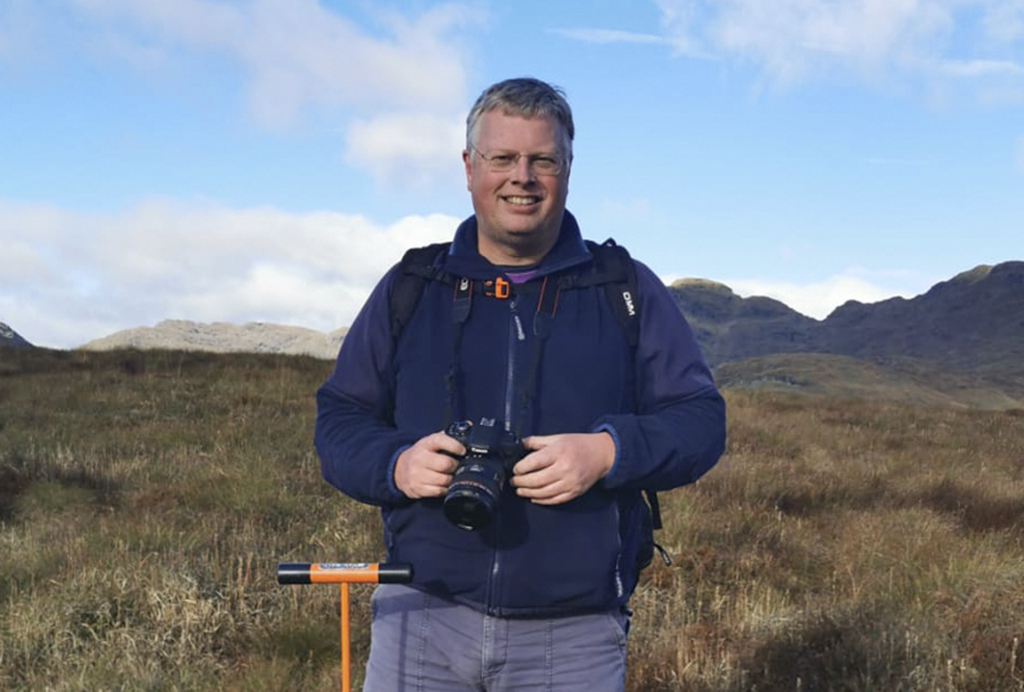
Ian McKee, Forestry and Land Scotland’s open habitat ecologist
In the time that I have been with Forestry and Land Scotland, we have begun restoration work on over 60 sites around the country. Although each site is different, each also has its own unique aspect that sticks in the mind aend the ‘Kyle Farm 1’ peatland restoration project is no different.
The thing about this site is its location in the landscape…and the fact that it is on Skye, which I first visited on a holiday over 30 years ago. Visiting would still feel like a holiday if it wasn’t for the running about trying to visit as many peatland sites and cover as much ground on each as possible. Getting to Skye from where I’m based in Lochgilphead is a lengthy commute….and when there are so many sites to visit, time is always precious.
The blanket bog at Kyle Farm 1 – about 2.5km away from the Kyleakin to Broadford road – sits well above the road on a flattish terrace. It lies below the main bulk of the Kinloch hills but is overlooked by this dark, brooding mass of upland.
The feeling of remoteness and peacefulness at the site is not disturbed by the tourism and local traffic on the road far below. It’s easy to sit there and think that you have the place to yourself, that no one else knows about it or cares about it, never mind relies on it – except maybe the occasional white tailed eagle flying overhead and scouting the site for prey.
The uphill ground to the east is designated as a Special Area of Conservation (SAC) because of the quality of the open habitats within it, including small pockets of peat supporting Blanket bog. Although not part of the adjacent, uphill SAC, the Kyle Farm 1 project area has a more extensive area of peat and is deeper than most of the peat on the SAC.
It was this area – a mixture of blanket bog and wet heath, both priority habitats – that 30 years ago had been ploughed and drained…‘modified’ so that it could be planted up with conifers. These types of habitats only gained protection in Scottish law in 2004. But our appreciation of the importance of these habitats had evolved so far since this site was planted that by around the year 2002, the young conifers had been cut down as a first step towards restoring the site.
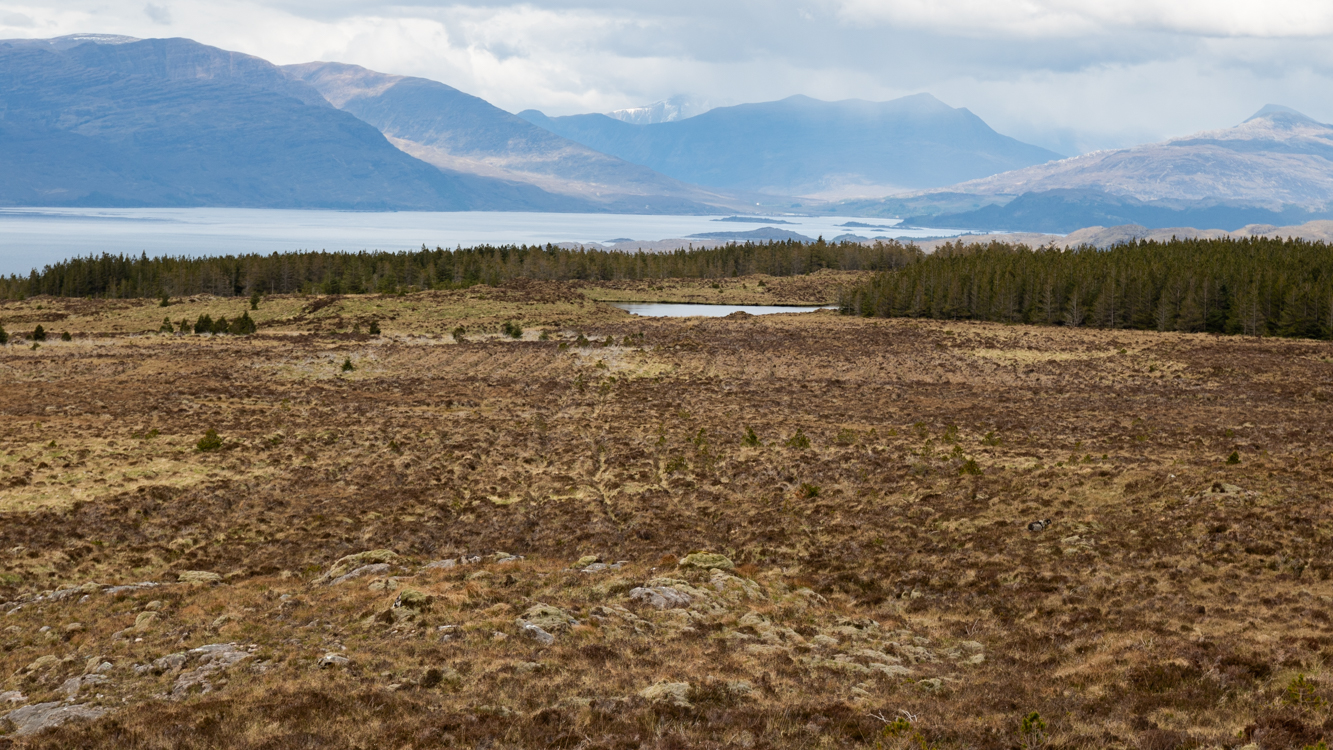
The ploughed ridges and furrows can be seen in the middle ground, the curved lines running between the ridge in the foreground and the lochan (Photo taken May 2019)
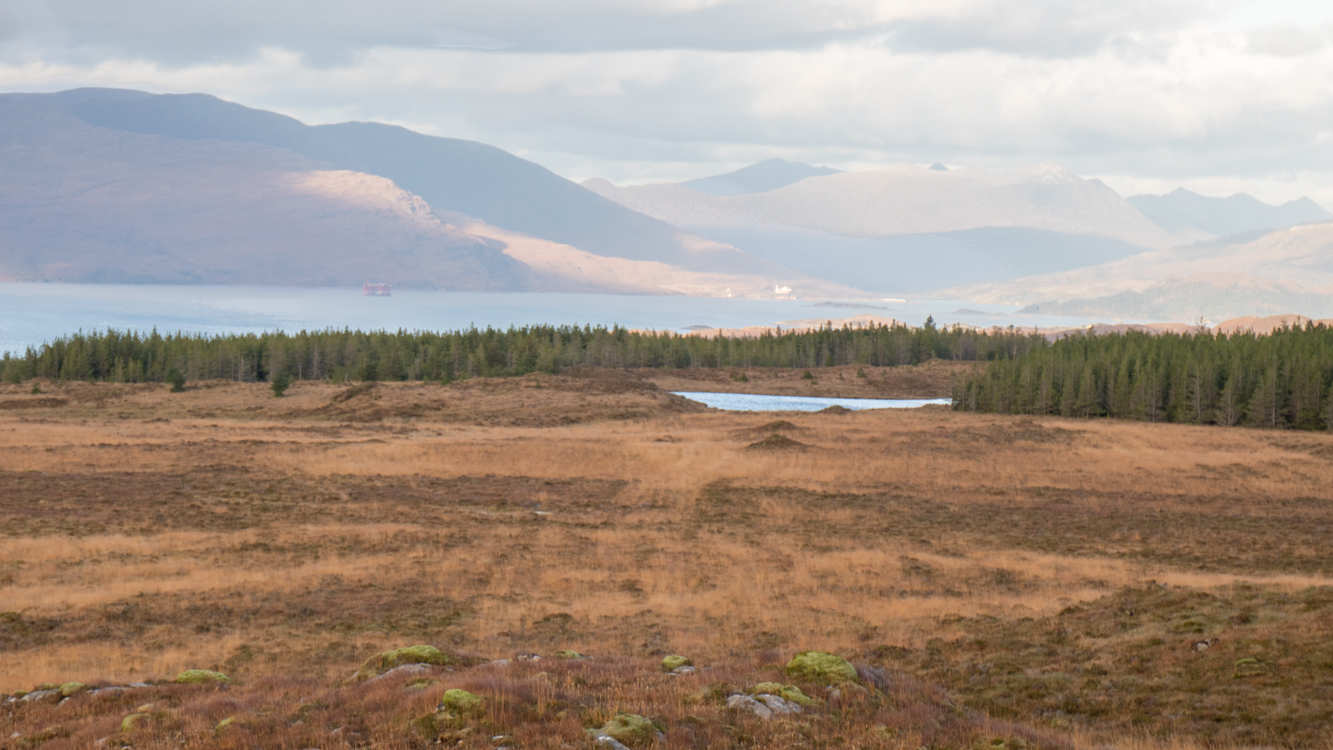
The same vantage point as the above photo. The ploughed ridges and furrows have been smoothed and drains blocked with peat dams. As a result, the heather has reduced in vigour and cover, and other peatland species such as molinia have increased their extent. This is a positive change. (Photo taken in October 2021)
It was clearly the right thing to do – although still a pioneering approach to take back then – but the ploughed ridges and furrows remained prominent and the drains were left running and unblocked. It was thought, if left alone, that nature would heal itself.
Thankfully, our understanding of peatland restoration techniques – especially in the last five to 10 years – has evolved along with our appreciation of peatland. We also now know that modified peatlands – just like the cars and buses on the road below the site – are a source of carbon dioxide and therefore a contributor to changing our climate.
Our first ‘restoration’ visit to the site in 2018 was to identify the boundaries of the project area, and prescribe what actions we would take for habitat restoration. It involved checking peat depths and noting that the water in the drains was not flowing at such a rate as to have cut down through the peat to the underlying rock. Had that been the case it would have been much harder – and more costly – to block the drains such that the water would disperse into the peatland again. Fortunately, this situation affected only a relatively small part of the area where the peat was shallowest and the slopes steeper.
With the decisions on how to remediate the site taken, we engaged a contractor to come on to the site. Their job was to lift and set aside the existing vegetation, push the disturbed peat that made up the ridges back into the excavated furrows, then put back the reserved peatland vegetation on the tops again, pressing it down gently.
It sounds comparatively easy – but it’s a challenging job that requires great skill and a lightness of touch when it’s being done using an 8 tonne excavator! Watching an enthusiastic machine operator striving to restore a peatland in the best possible way is a fantastic thing to see.
Once that process was completed, peat dams were installed to block the drains and disperse and shed the water over the bog as it would have been for countless years before.
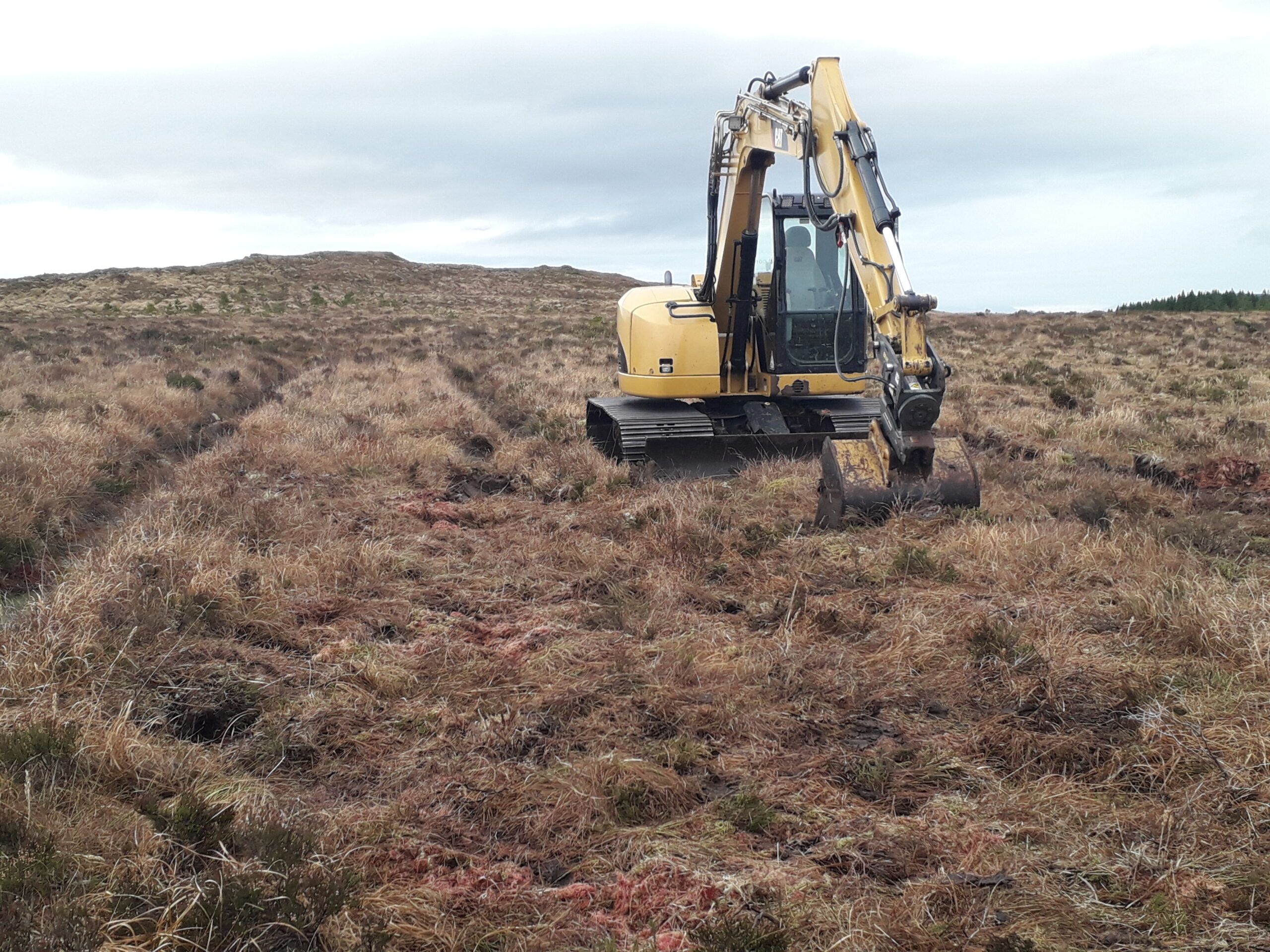
It’s a kind of magic: the re-profiling of the ridges and furrows has already been completed on the right hand side and in the foreground. The plough furrows can still be seen behind and to the left of the machine, but not for long
Kyle Farm 1 was also memorable because it was a colleague’s first experience of the intricacies of peatland restoration techniques. It is great to work beside people who are learning about the skills and processes required to successfully do restoration work; they think longer about how they are going to do it, discuss the approach with experienced colleagues, write the specifications to suit the site and the work, and then carry out checks on progress while the work is happening. It’s a steep learning curve and it’s rewarding to be able to pass on some of my knowledge gained from years of experience.
The first site that anyone works on is also one that they will return to often in the following years, checking how it is progressing…some even doing so in their own time outside of their work commitments. It’s a great illustration of just how passionate land managers are about their work and illustrates how attached we are to the land that we manage.
As is the intention with all of the peatland restoration projects we do, the ground at Kyle Farm 1, will become consistently wetter throughout the year. This will create the conditions that will provide many peatland species with an opportunity to thrive – species like bog asphodel, crowberry, marsh clubmoss, and cross leaved heath. But as the site gets wetter it will – especially in times of drought – allow more sphagnum to grow and spread.
This should create the conditions that will provide many peatland species with an opportunity to thrive – species like bog asphodel, sundews, cross leaved heath, bog myrtle, white beak-sedge and few-flowered sedge, and as the site gets wetter it will allow more Sphagnum moss to grow and spread. The benefits to biodiversity are realised almost immediately. However, it is thought to take 10 years after restoration before a peatland stops acting as a carbon source.
As new layers of moss grow, the older layers will die off and, mostly unrotten, be incorporated in to the bog, taking their stored carbon with them and eventually forming new peat.
Whilst there was no re-wetting work carried out until 2019, trees were cut from the site in 2002, making it what is thought to be the second ‘forest to bog’ restoration project started in Scotland. The first forest to bog project was Longbridgemuir, part of the Lochar Mosses lowland raised bog complex near Dumfries, where trees were removed in 2001. The first re-wetting of a peatland carried out by Forestry and Land Scotland was at Drumbow near Caldercruix in 2003. The first ever peatland restoration project I worked on was in County Tyrone in Northern Ireland in 2005.
It is great to leave a part of the land that we manage in a better condition than it was when I first encountered it. It is hugely satisfying to look at the contrasts between the ‘before’ and ‘after’: a constant reminder that I have the best job – and some of the most conscientious and focused colleagues – in the world.
And it’s gratifying to know that in some small way, we’ve made our own contribution to tackling the Climate Emergency.

Above photo taken October 2021

The flushed peatland is characterised by the Molinia grasses, rust coloured at this time of year (Photo taken October 2021)
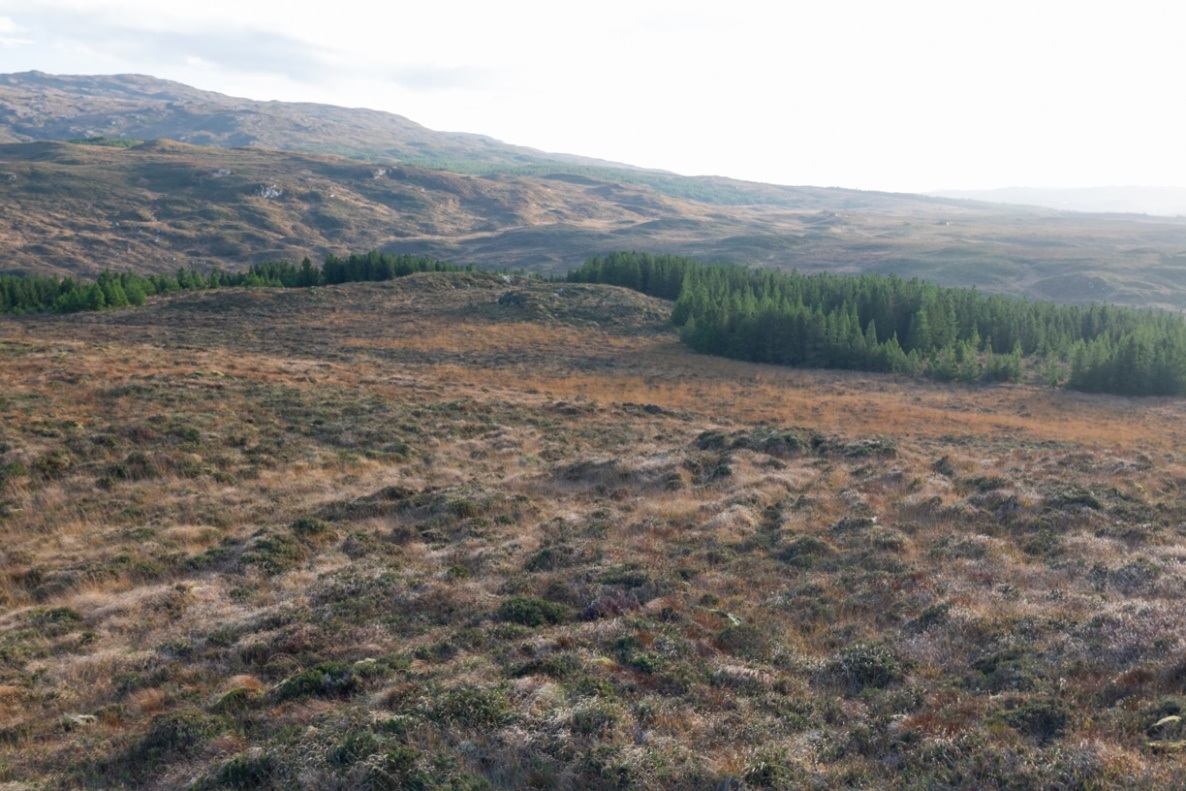
For more information, people can visit this part of FLS website and see more about the various projects: https://forestryandland.gov.scot/what-we-do/biodiversity-and-conservation/peatlands
TAGS

